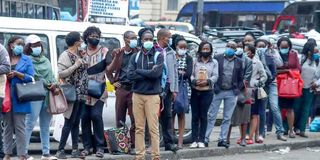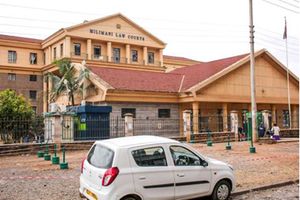Premium
Police turn a blind eye as PSV crew disregard Covid-19 safety rules

What you need to know:
- With matatus now operating at half capacity, passengers have been footing operation costs by digging deeper into their pockets.
- Ordinarily, passengers pay Sh100 from the city centre to Kasarani during rush hour.
A traffic police officer pulls an MSL Sacoo bus over near the Thika Road Mall roundabout in Nairobi. After realising that six passengers are sharing seats, the officer walks to the driver’s door. A brief chat, a knowing look and a discreet bribe later, the unbothered officer signals him to drive on. The crew has just got away with the offence of failing to enforce social distancing rules.
When Covid-19 struck, the chaos that has characterised Kenya’s public transport for years was brought to the fore. From poor regulation to pervasive corruption, inefficient Saccos and exploitation of passengers, the confusion has persisted, only worsened by the pandemic.
The current crisis caused commuters the dilemma of choosing between safety and being able to move around.
PROTOCOL
In the Protocol for Public Road Transport Operations announced on Wednesday by the government, matatus are required to establish measures to enforce social distancing, contact tracing and to manage suspected cases of Covid-19.
“We’ve put in place an inspection and certification process of ensuring PSV operators observe the new protocol and guidelines issued by the Ministry of Health,” Transport Cabinet Secretary James Macharia said.
Even after suspension of the ban on inter-county movement, most of the bus operators who spoke to the Nation lamented that their Saccos had yet to communicate to them the way forward.
“We’re waiting to hear from the sacco management what we need to do before we can start travelling,” Mr Josphat Mutua, a driver with Manatwa Sacco, which plies the Nairobi-Kitui route, told the Nation.
A spot check by the Nation on most routes in the city showed that strict adherence to the Health ministry guidelines hasn’t been possible due to structural challenges.
At various bus termini, where long queues are seen during rush hour, no social distancing is observed as agitated passengers push and shove. Many are tired after work and want to get home before the curfew begins.
HALF CAPACITY
‘‘Every evening you have to fight to board the bus. It’s annoying,’’ Ms Michelle Barasa said at MSL’s Tom Mboya Street terminus, adding that she has had to leave work early for the last three months.
But what has the situation on city roads been like in the last four months?
With matatus now operating at half capacity, passengers have been footing operation costs by digging deeper into their pockets. This is particularly painful for commuters who use matatus to get to work every day.
A 2018 report by Deloitte showed that 70 per cent (three million) of Nairobi residents use matatus to go to work every day. In total, more than 4.5 million people commute through the city.
Ordinarily, passengers pay Sh100 from the city centre to Kasarani during rush hour. But the fare can be as little as Sh30 during off-peak hours.
But for months now, Expresso, Mwiki Sacco Limited and MSL buses have been charging a flat rate of Sh100.
While the operators initially offered passengers sanitiser, this slackened with time. Passengers now board the vehicles with unsanitised hands, putting others at risk of infection.
Cunningly but in complete defiance of safety protocols, matatu crew still carry extra passengers. There was a time commuters would protest whenever the crew took excess passengers in buses. But they have mellowed with time, as the crew puts everyone at risk of infection.
Afraid to use public transport, some Kenyans have opted to use private means or taxis, leading to a spike in the number of private vehicles on city roads.
PUBLIC TRANSPORT
‘‘It’s more convenient and safer to use a cab than a matatu,’’ Ms Esther Githaiga told the Nation, saying that it costs her between Sh600 and Sh800 to move from the CBD to Karura in Kiambu County every day. Public transport would cost her less than Sh150 both ways.
“It’s expensive, but I feel safer. Besides, I work for only three days a week,” she says.
In the predominantly cash-based public transport system, payment of fares through mobile money has not caught on.
Some conductors, stuck to their old ways, ask passengers: ‘‘Kwa nini hauna cash (Why can’t you pay in cash)?’’
‘“There are too many transactions. It’s also intrusive to ask a passenger to allow you to verify the payment,’’ said bus conductor Elijah Mwariri, noting that his employer hasn’t got a till number.
Even with the work-from-home directive, traffic congestion in Nairobi is still as agonising as ever. The situation on Mombasa Road and the Thika Superhighway, known for snarl-ups that last for hours, has barely changed. The economy loses about Sh7 million daily thanks to traffic congestion in Nairobi alone.
Elsewhere in the world, governments advise their citizens to cycle or walk to work to avoid infection in crowds and also ease pressure on public transport.
During the first three weeks of lockdown in the UK, for instance, the number of passengers using London’s underground train network dropped from 3.98 million per day to only 200,000.
Without proper lanes for pedestrians and cyclists in Nairobi, walking or cycling to work isn’t a safe option. Cyclists account for only one per cent of traffic on city roads, according to Deloitte.
While they have continued to operate during this time, the Nairobi-Syokimau and Nairobi-Ruiru trains barely have the capacity to move the ever-bulging city population.





